Introduction
Whether businesses are in a good or critical situation, they need techniques to analyze their current situation to develop the right strategy.
But how can a company define where it is coming from? Where does the company want to go? Which strengths helped the company to thrive from past to present? Which weaknesses exist in a company that must be naturalized or might even be changed into strengths?
Regarding the market: Which opportunities and threats can be expected? SWOT analysis answers all these questions in a structured, analytical, and integrated way.
Strengthening your business core and its position in the ever-evolving market is difficult.
You develop a strategic plan, hoping to optimize business operations and hit it big. But is it that simple? Of course not!
You can’t level up unless you are unaware of your current state and its effectiveness. That is where SWOT analysis comes in.
Because managing an organization requires you to know what is working, identify areas of weakness that need attention, and determine how to take advantage of opportunities while avoiding threats.
So, let’s go over to understand what SWOT analysis is and how to use it effectively. Also, learn its benefits, drawbacks, and an example to get the most out of your hustle.
What is a SWOT Analysis?
A SWOT analysis examines an organization’s internal and external strengths, weaknesses, opportunities, and threats. All four elements are the key to understanding your business thoroughly and building compelling business strategies.
This framework gives you a comprehensive and transparent picture of your organization’s functions. You can determine your strengths and weaknesses and forecast and recognize opportunities and threats for effective strategic management.
You must conduct SWOT before making any significant business decisions. For example, you can use it to know your competition better, assess potential business risks, or develop brand strategies to get an edge.
Note: SWOT analysis can be run for any product, project, initiative, or organization.
What are the critical elements of SWOT analysis?
The four critical elements of SWOT analysis are:
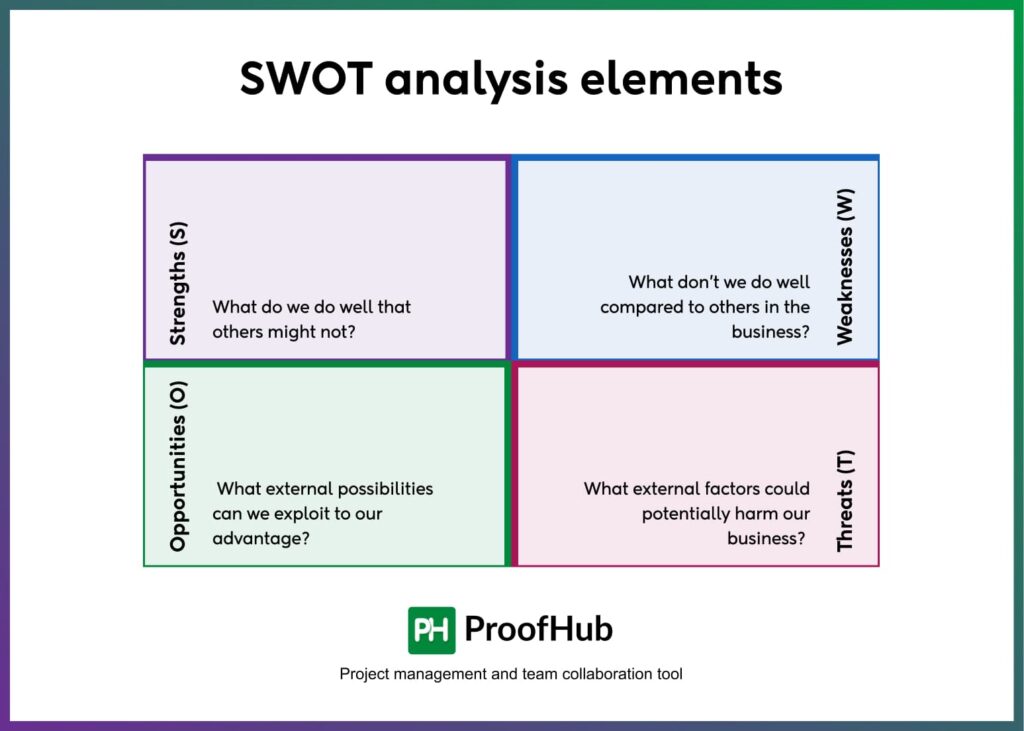
1. Strengths (S)
What do we do well that others might not?
These internal attributes or initiatives are operating fine in your organization. These features are unique to your operations. They benefit your organization in a way that sets you apart from the competition in the industry. Precisely, these capabilities enable your company to perform well- capabilities that need to be leveraged.
For example, a skilled workforce is a significant strength of an organization to boost productivity and innovation.
2. Weaknesses (W)
What don’t we do well compared to others in the business?
Weaknesses are the internal initiatives that prohibit your company from performing well and must be addressed. – These hinder your performance and put you at a disadvantage. Recognizing weaknesses sets decision-making as the baseline for improvements and strategic planning.
For example, high employee turnover rates indicate issues within company culture that could strain organizational stability and disrupt business operations.
3. Opportunities (O)
What external possibilities can we exploit to our advantage?
These are the external trends, forces, and chances you could claim and exploit to achieve optimal results and gain a competitive advantage. You must be proactive and efficient in these beneficiary avenues to capitalize on. These can have a small to massive impact on your competitive position.
For example, adapting to emerging technologies is an opportunity that can help you dominate the market.
4. Threats (T)
What external factors could potentially harm our business?
Threats are the vulnerable factors that could potentially deteriorate your business from the outside. Even though you lack control over these variables, you can build proactive strategies to safeguard your business dynamics. That is why identifying threats is essential for risk management and improving your position in the market.
For example, supply chain disruptions due to global events or tension are a threat that can impose noticeable challenges to your business.
How to do a SWOT Analysis?
Every organization is unique and prone to witness different challenges and obstacles. You can bring personalization to your SWOT analysis by uncovering your business-specific insights and developing effective strategies around them.
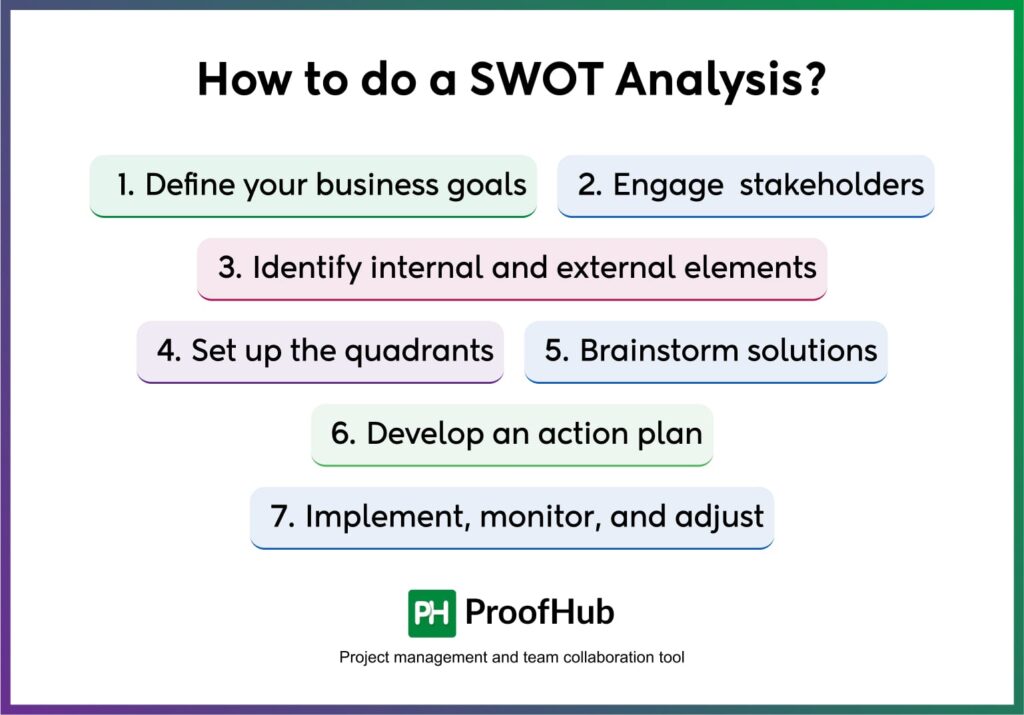
Here are the key steps to conduct an impactful SWOT analysis for your organization.
1. Define your business goals
SWOT provides a comprehensive perspective on your organization’s strategic position. Therefore, having defined objectives increases the likelihood of obtaining relevant insights. Whether it is evaluating a specific department, a new product line or your overall business strategy Having a well-defined goal helps you focus on key areas, brainstorm your solutions, and strategize your approach accordingly.
2. Engage stakeholders
Next, bring together a varied group of individuals to be a part of your SWOT analysis. Be it your team members, external stakeholders, or clients- their perspectives offer valuable insights. This also ensures that no blindspot remains uncovered, and you can thoroughly explore every detail.
3. Identify internal and external elements
With everyone onboard, start analyzing your organization’s internal and external factors by hosting a brainstorming session with your team.
3.1 Internal factors
The parameters that are internal to your company and are in your control are called internal factors. For example, every company has unique strengths and weaknesses that you can readily access within your organization.
Some questions to ask when determining your strengths and weaknesses are –
Strengths
- Which of our offerings are most loved by customers?
- What is our USP?
- What gives us a competitive edge?
- Do we have a loyal customer base?
- What are the unique talents and expertise of our employees?
Weaknesses
- Are there any inefficiencies in our processes?
- Is our technology outdated or hindering our performance?
- Are our employees engaged and motivated?
- How is our financial health?
- Are there any skill gaps to consider?
Make sure to keep your assessment factual and objective. Do not let intuition take the lead.
3.2 External factors
The elements that are external to your organization and beyond your control are called external factors, such as opportunities and threats. These parameters are equally influential as internal factors.
You can begin identifying both these measures by asking questions –
Opportunities
- What are the latest industry trends?
- What are the opportunities your competitors overlook?
- Which customer needs or pain points are still unaddressed and need attention?
- Are there any favourable economic conditions that you can exploit?
- What are the new regulations that could benefit your business?
Note: Prioritize and rank the opportunities to take effective action.
Threats
- Are there any potential events that could disrupt your business operations?
- Who among your competitors is giving you immense competition?
- Are there any adverse changes in consumer behaviour and demands?
- How can the latest technological advancements disrupt your current operations or processes?
- Are there any potential economic downturns?
4. Set up the quadrants
Once you get answers to the above questions, start organizing the information. You can do that in two ways-
- Using the four-quadrant structure of a SWOT marketing template and mentioning obtained factors under each category.
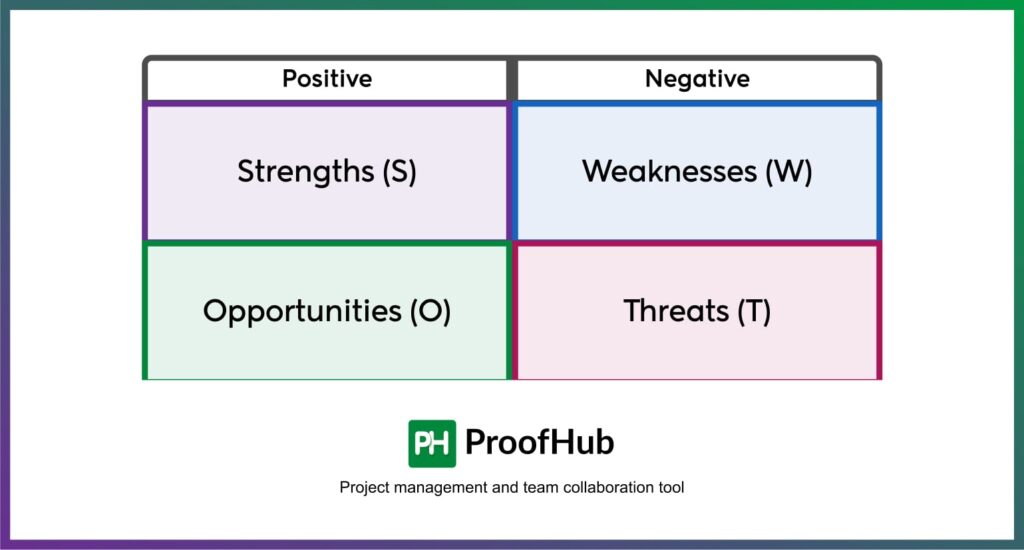
- List the factors on a 2X2 grid made on a whiteboard or paper.
Note: When filling in the quadrants, make sure to use bullet points or number the points. It is recommended not to over-explain the details here. Be specific and concise.
5. Brainstorm solutions
Host a workshop or a meeting to brainstorm innovative solutions and ideas. Make sure to set the intention for the session so that no one deviates from the objective. Bring in stakeholders from across the departments, but be mindful of the individuals you invite. Why? Because too many people can disrupt the wind. Ensure the discussion remains goal-oriented and productive.
6. Develop an action plan
Translate SWOT analysis insights into a strategic action plan. – You should clearly outline your objectives, outline required -resources, and detail actionable steps to capitalize on strengths, mitigate weaknesses, exploit opportunities, and counteract threats.
7. Implement, monitor, and adjust
Once your action plan is ready, execute it with precision. Also, always stay in sync with the implementation progress and make adjustments so that nothing falls through the cracks.
Examples of SWOT Analysis
Since you now recognize all the SWOT key elements and the process of running a SWOT analysis, let’s understand its application through a real-life example.
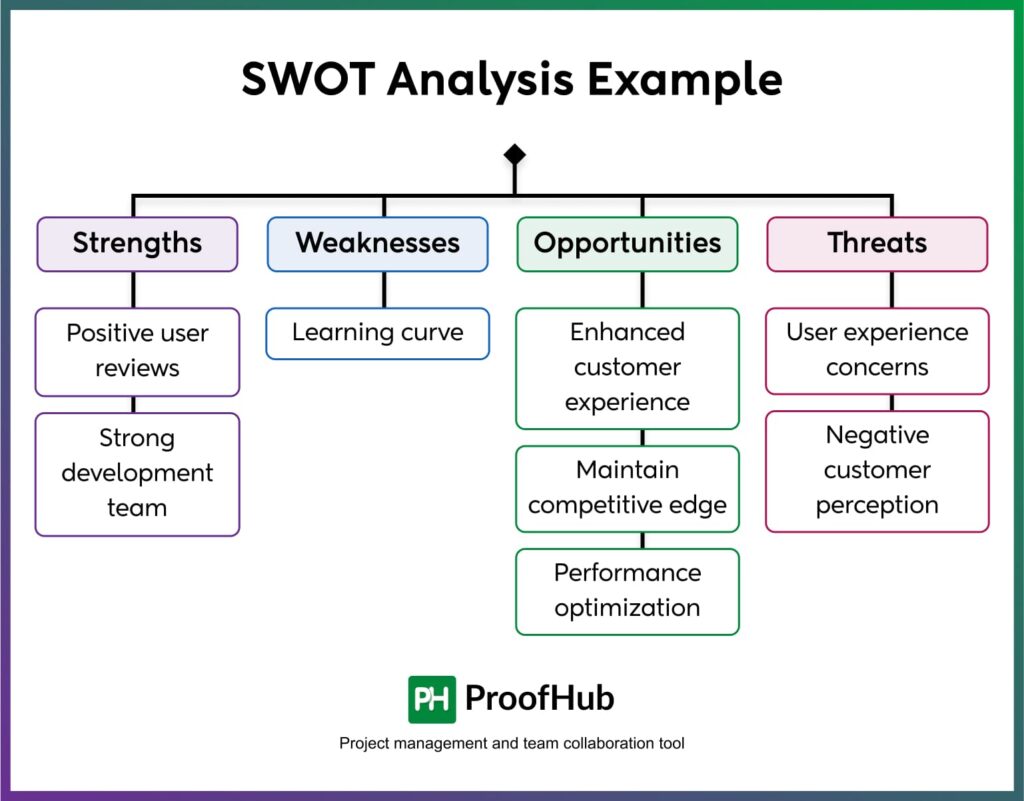
Here is a review of how we used the SWOT technique to build the new ProofHub version:
Strengths
- Positive user reviews: Our flat fee pricing, user-friendly interface, and robust functionalities have gathered consistently positive feedback, making us at par with our competitors and a preferred choice.
- Strong development team: Our talented developers excel at understanding user needs and building innovative solutions.
Weaknesses
- Learning curve: We recognize that users were accustomed to the previous version and may face challenges adapting to the new layout and functionalities.
Opportunities
- Enhanced customer experience: The new and redesigned version offers the potential to make the software more intuitive and user-friendly.
- Maintain competitive edge: Launching this new version helps us stay competitive in the constantly evolving market landscape.
- Performance optimization: We can focus on enhancing product versatility and reliability within this update.
Threats
- User experience concerns: There is a high risk that the new version’s design, functionality, and usability may not meet user expectations.
- Negative customer perception: There is a high chance that users perceive the new version as a downgrade to the previous one.
Based on these insights, we strategically planned to build a new product version that enhances user experience and streamlines interaction with the product. The redesigned version allows users to navigate seamlessly to their desired features and information.
When to use SWOT Analysis?
SWOT analysis is not suitable for use in all situations. It’s more useful when you aim to make strategic decisions and plan for the future.
- Strategic Decision-Making: Use SWOT analysis when making pivotal decisions or planning future initiatives.
- Business Assessment: A comprehensive view of your company process and performance from various perspectives.
- Identifying Growth: Identify areas of weaknesses for improvement and opportunities for expansion.
- Business Planning: Revamp existing strategies or launch new initiatives to improve your business plans.
- Product Development: Decide whether to develop and execute a new product or service to the market.
Why SWOT analysis is important?
SWOT analysis allows you to capitalize on opportunities to stay relevant in the changing business landscape.
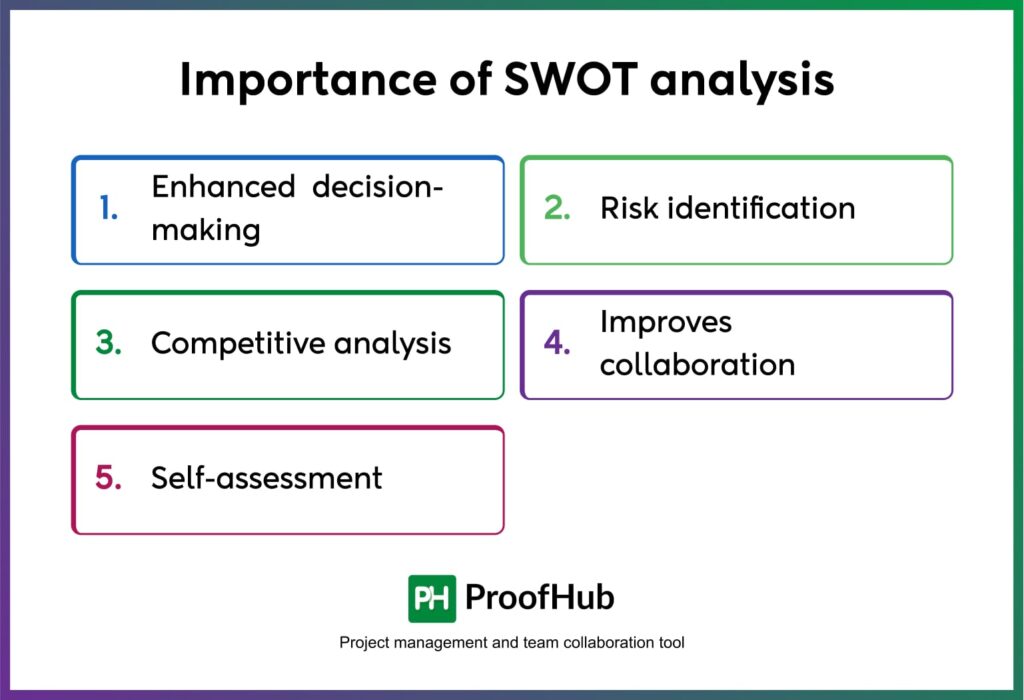
Here are a few parameters which make it a valuable business practice.
1. Enhanced decision-making
SWOT analysis decodes your organizational performance and makes it easy for you to identify and understand internal and external factors. Not only this, but you also get to evaluate the impact of these on your business operations. Using this information, you can make informed decisions and tailor your strategies to obtain optimal outcomes and growth.
Produce well-though and strategic results for your SWOT analysis through rapid decision-making
2. Risk Identification
It is a common practice for every organization to maintain a risk register. However, in any case, if you don’t, SWOT analysis can keep you updated on all the possible risk components – both within and outside the industry, before they become serious trouble. With these insights, making contingency plans and taking proactive measures becomes easy.
3. Competitive Analysis
SWOT analysis helps businesses evaluate their competitive position in the market. You can analyze your current performance by highlighting your unique selling points and weaknesses to achieve optimal performance. They can build strategies around these insights to stay responsive, adaptable, and ahead in the market.
4. Improves collaboration
Running a SWOT analysis requires a group effort. This means different inputs and perspectives are considered, and everybody values each other’s opinions. This collaborative approach fosters open communication between stakeholders and team members, enhancing company cohesion and driving collective progress.
5. Self-assessment
Companies that run SWOT analyses are self-aware of their core operations and practices. They understand the areas where no one can beat them and the weaknesses that hinder their growth. They are always looking for opportunities to stay ahead and hit their targets.
What are the pros and cons of SWOT analysis?
There are some undeniable benefits to SWOT analysis, which are widely recognized. However, despite the advantages, the practice is not without any drawbacks.
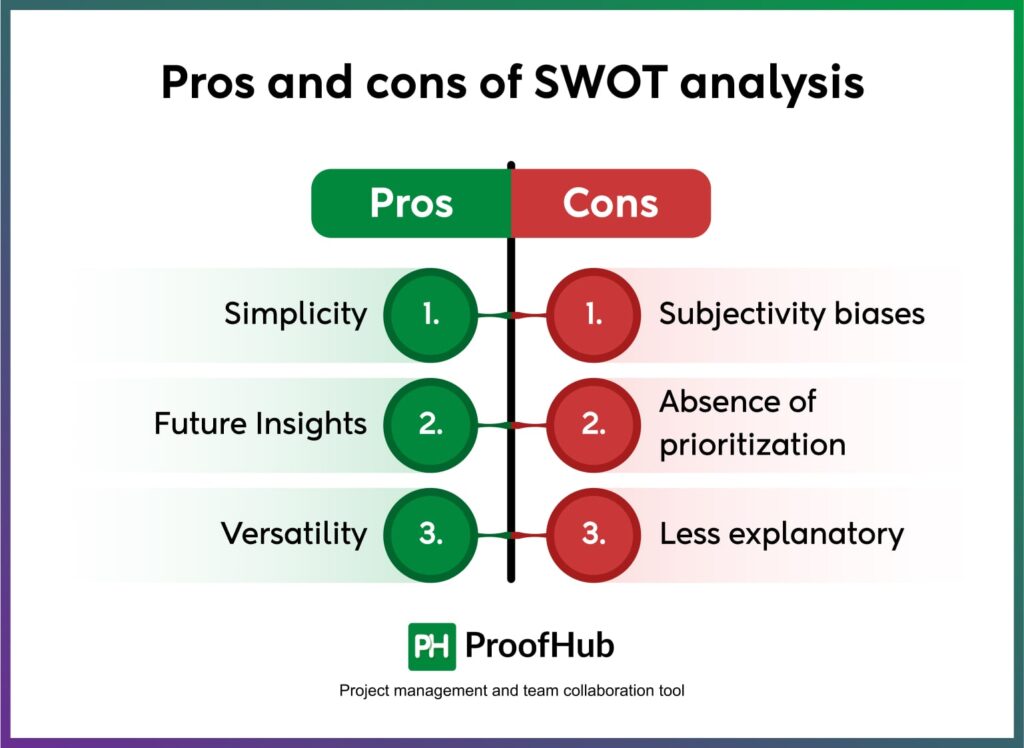
Pros of SWOT analysis
1. Simplicity
SWOT analysis is pretty easy and straightforward to use. You do not need specialized expertise or technical knowledge to run this for your organization. Individuals with any experience and expertise can participate in the process to uncover the four major components of SWOT. Based on these factors, making strategic plans becomes easier.
2. Future Insights
SWOT analysis goes beyond obtaining the visibility of the present landscape, helping organizations anticipate future challenges and opportunities. By assessing external factors such as market trends and risks, businesses can develop strategies to navigate uncertainties.
3. Versatility
One of the SWOT analysis’s strengths lies its adaptability across different contexts. It is not limited to evaluating your organization’s effectiveness; it also includes assessing projects, products, and processes. This flexibility helps businesses to make informed decisions across various facets of operations.
Cons of SWOT analysis
1. Subjectivity biases
SWOT analysis is prone to subjective biases. Each individual brings unique perspectives to the table, which often results in inconsistencies and misinterpretations. This impacts the objectivity of the SWOT analysis and requires careful facilitation to mitigate biases.
2. Absence of prioritization
Another notable limitation of SWOT analysis is its inability to prioritize factors within each quadrant. All you are left with afterwards is a bunch of elements to concentrate on and no clear direction on which task to prioritize. This situation increases the chances of wasting your efforts, resources, and time on parameters that have little to no importance and impact your organization’s success.
Learn the practical ways to prioritize tasks and manage your workload for better productivity
3. Less explanatory and without recommendations
There is no denying that SWOT analysis undoubtedly provides a broad snapshot of an organization, but it often lacks detailed recommendations for action. For example, after identifying potential threats, it may not specify actionable steps to mitigate them. This gap between analysis and implementation fades its effectiveness in obtaining strategic initiatives forward.
Conclusion
SWOT analysis is a robust and structured methodology that organizations use to improve efficiency and drive success. Businesses can develop strategic plans by systematically evaluating Strengths, Weaknesses, Opportunities, and Threats that capitalize on their strengths and mitigate potential risks.
If you need assistance conducting a practical SWOT analysis, you can use ProofHub, a versatile project management and team collaboration tool. Whether for organization strategy, project planning, or product development, ProofHub helps categorize analysis insights into manageable, organized, and actionable information with ease.
FAQs
What does a SWOT analysis identify?
A SWOT analysis identifies your organization’s strengths, weaknesses, opportunities, and threats. These insights are crucial for improving organizational efficiency and developing strategic plans.
What are the purposes of a SWOT analysis?
The primary purpose of SWOT analysis is to figure out your company’s internal strengths and weaknesses. It also lets you recognize possible risks and business possibilities within the marketplace.
How to use a SWOT analysis?
SWOT analysis helps you set or reaffirm goals and ensures you accomplish them with assurance. Examine the threats and vulnerabilities to think about your course of action. Lastly, to obtain a competitive advantage, maximize your strengths.
What is the most important part of the SWOT analysis?
The most important aspect of SWOT analysis depends on the context and goals of your organization. For example, the parameter that delivers the most value to your organization is considered the most significant aspect of SWOT analysis.
How to write a good SWOT analysis?
To write a robust SWOT analysis, conduct a comprehensive assessment of your organization from every angle. Gather relevant information, ask probing questions, and brainstorm ideas for each SWOT category. Lastly, data should be categorized and prioritized into a 4-quadrant table for a clear, structured list format.
How does SWOT analysis help in strategic planning?
SWOT analysis proves to be a great help in strategic planning. It does so by bringing a comprehensive business outlook into the plan. From strengths and weaknesses to opportunities and threats, SWOT assists you in redefining your strategy and obtaining results faster.

